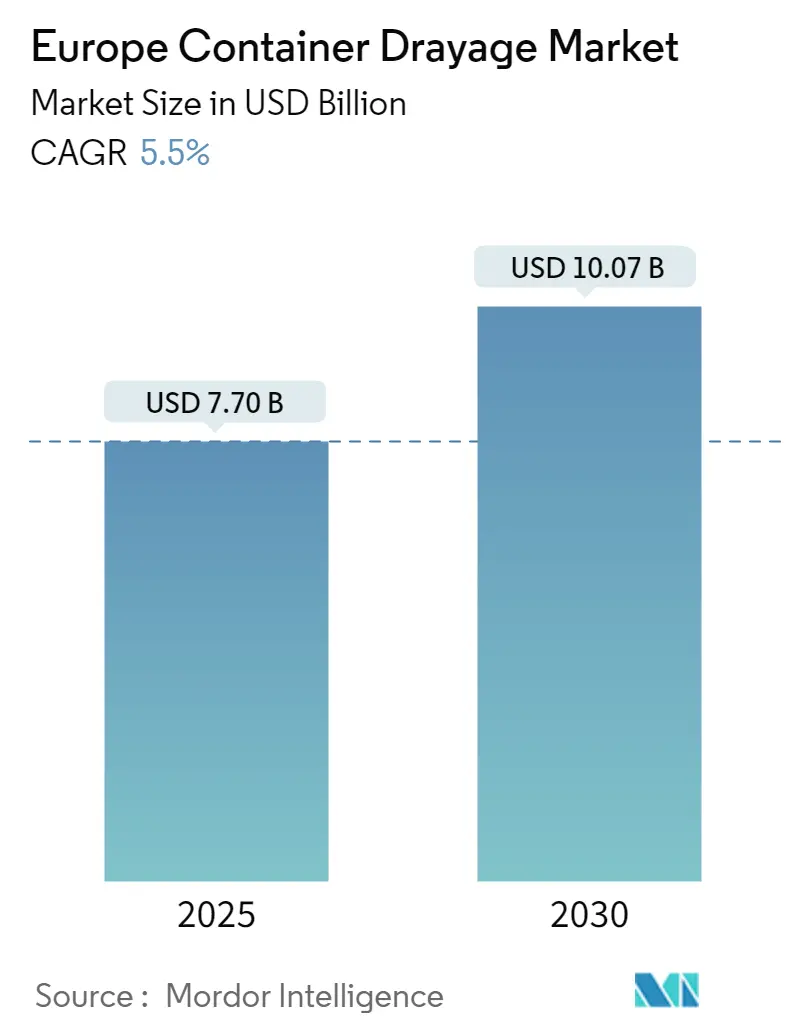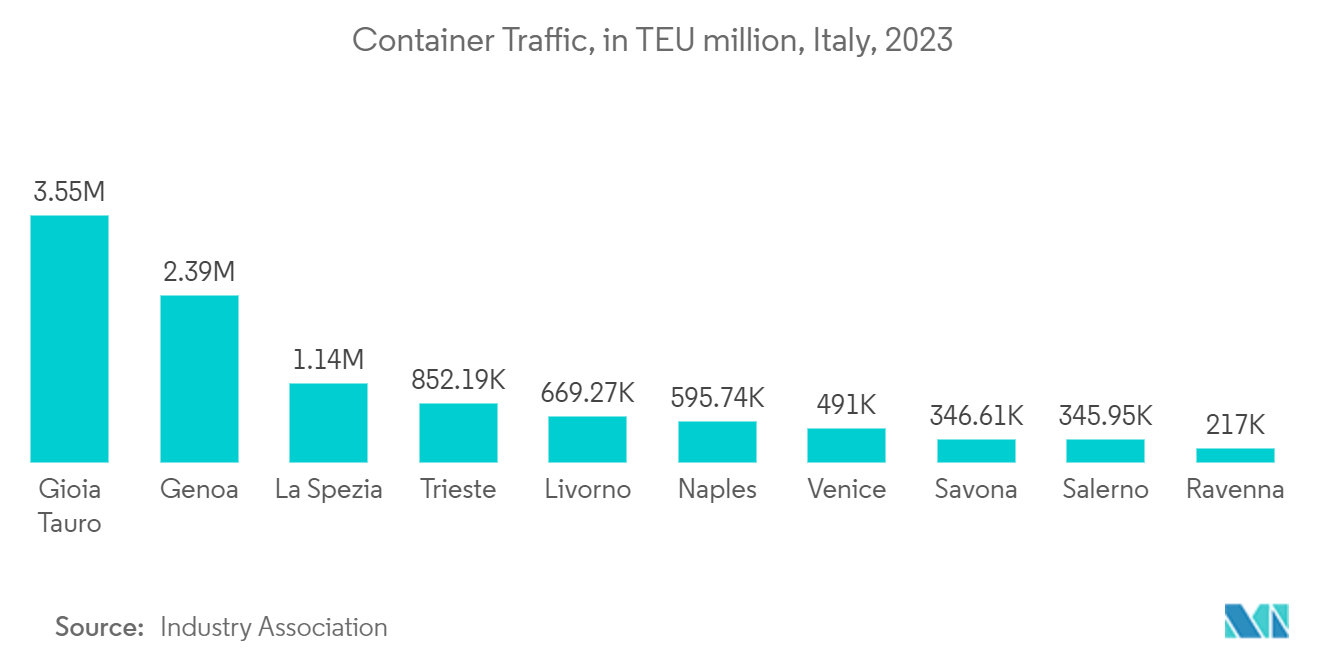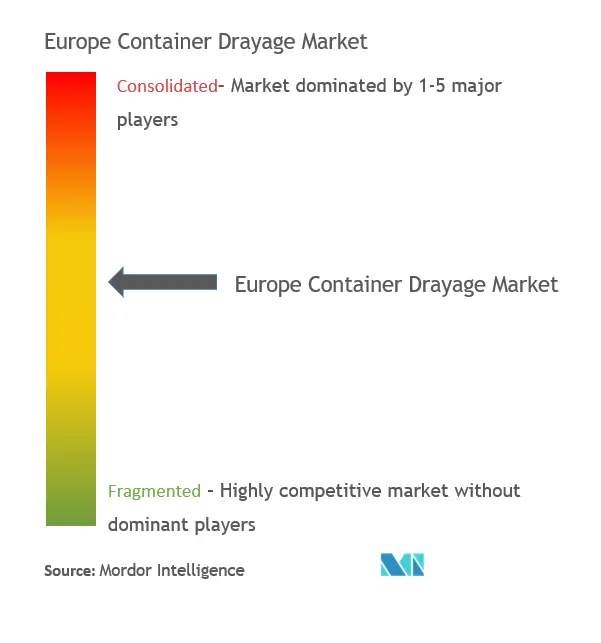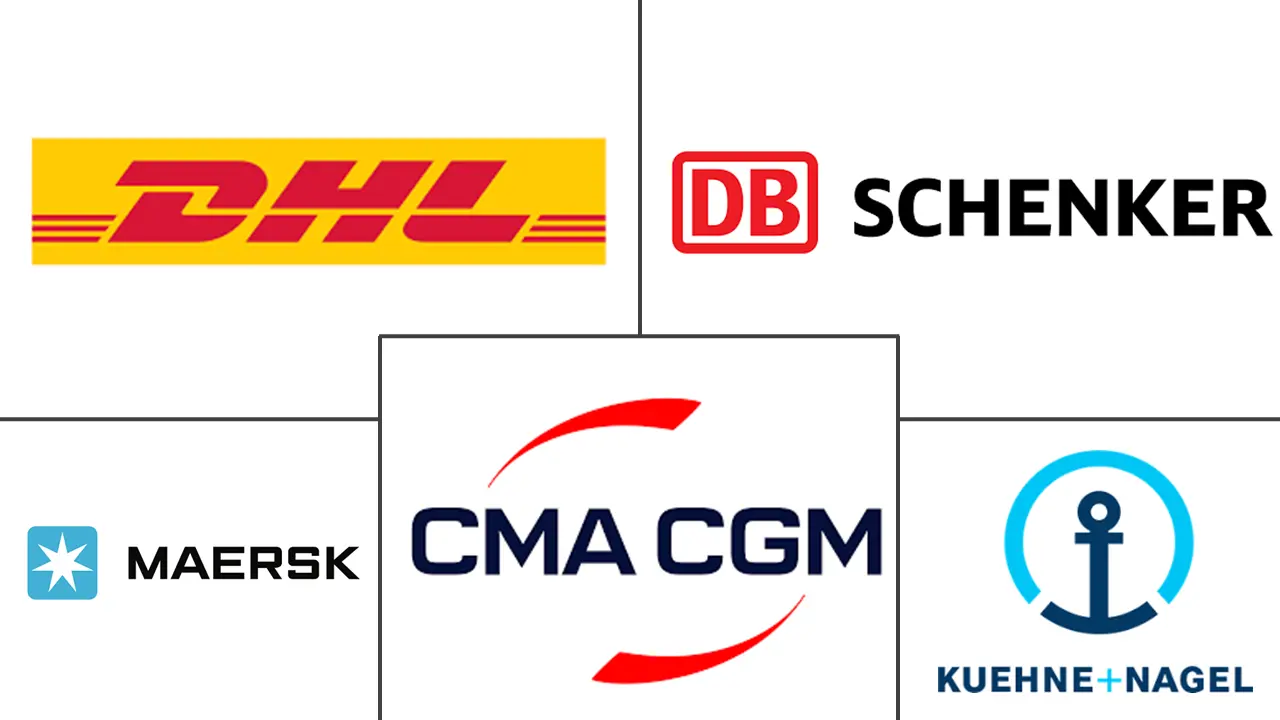Europe Container Drayage Market Size and Share

Europe Container Drayage Market Analysis by Mordor Intelligence
The Europe Container Drayage Market size is estimated at USD 7.70 billion in 2025, and is expected to reach USD 10.07 billion by 2030, at a CAGR of 5.5% during the forecast period (2025-2030).
- The European container drayage market is driven by trade growth, infrastructure development, technological advancements, and sustainable initiatives.
- The increasing volume of international trade and containerized cargo moving through European ports is a significant driver for the container drayage market. Europe is poised for a robust recovery, with export growth projected to surge by 2.2% in 2024, marking a significant uptick from the 0.4% growth in 2023. Correspondingly, after a dip in 2023, import trade volumes have been forecast to rebound by 1.6% in 2024.
- Challenges, including elevated interest rates, surging inflation, the prolonged conflict in Ukraine, and weakened global demand, weighed heavily on European trade volumes in 2023. However, with a projected easing of interest rates in 2024, economic activity is anticipated to rebound, spurring demand for European exports.
- In 2023, the European cross-border e-commerce market surged, hitting a turnover of EUR 237 billion (USD 256.54 billion), a remarkable 32% leap from 2022. European online retailers have been instrumental in contributing EUR 107 billion (USD 115.82 billion) to this cross-border total. The broader European B2C e-commerce market also flourished, culminating in a turnover of EUR 741 billion (USD 802.09 billion), up by a notable 13%. Cross-border transactions notably comprised 32% of all online sales in Europe.
- Investments in infrastructure, particularly in road networks, ports, and intermodal facilities, are pivotal for ensuring the seamless operation of container drayage services, thereby driving the market forward.
Europe Container Drayage Market Trends and Insights
Demand for Containers Driven by Cross-border E-commerce
In 2023, the European cross-border e-commerce market witnessed a significant surge, reaching a turnover of EUR 237 billion (USD 256.54 billion), marking a notable 32% leap over 2022. European online retailers played a pivotal role, contributing EUR 107 billion (USD 115.82 billion) to this cross-border total. The broader European B2C e-commerce market also thrived, achieving a turnover of EUR 741 billion (USD 802.09 billion), reflecting a substantial 13% increase. Notably, cross-border transactions accounted for 32% of all online sales in Europe.
German online retailers led the way, achieving a substantial 28% increase in cross-border sales, totaling EUR 43 billion (USD 46.54 billion). In contrast, the United Kingdom experienced a slight dip of 1.8%, with cross-border sales amounting to EUR 27.5 billion (USD 29.77 billion), down from EUR 28 billion (USD 30.31 billion) in 2022.
French online stores saw a notable 30% surge, reaching EUR 32 billion (USD 34.64 billion) in cross-border sales. Additionally, Spanish platforms witnessed a significant 50% rise, reaching EUR 18 billion (USD 19.48 billion), while Dutch platforms also experienced a substantial uptick, hitting EUR 7 billion (USD 7.58 billion), marking a 45% increase.
In 2023, clothing and footwear emerged as the dominant product category in European cross-border e-commerce. A significant 60% of respondents surveyed extensively revealed a strong preference for purchasing items from this category through international online platforms. In contrast, consumer electronics secured the second spot, with only 27% of respondents opting to procure these goods from overseas.

Italy Emerging as a Lucrative Hub for Container Drayage Services
Italian ports boast a unique dual function within the nation's port ecosystem. While, like in most countries, they primarily facilitate import and export activities, Italian ports distinguish themselves by assuming a pivotal role as key hubs in southern Europe.
Geographically, Italy's peninsula not only bridges Europe with the eastern Maghreb but also serves as a prominent gateway to the heart of the Mediterranean. Notably, the primary maritime route in the Mediterranean, linking the Suez Canal's exit with the Strait of Gibraltar, runs near Italy's coast.
Furthermore, Italian ports have cultivated strong ties with Central European landlocked nations like Hungary, Austria, and Switzerland. Among these connections, Trieste emerges as the premier port, serving as the gateway to Austria and Hungary.
Italy boasts 20 ports spread across its mainland peninsula and the islands of Sardinia and Sicily. In 2023, the primary ports collectively managed 11.03 million TEUs, marking a 6.3% dip over 2022. However, this figure still surpassed the volumes seen in both 2020 and 2021. Notably, this decline mirrors a broader European trend, with nearly all major container ports facing setbacks in 2023.
In 2023, Italy managed nearly double the container traffic of France, handling around 5 million TEUs. Surprisingly, despite having a similar number of ports, Italy outpaced France. Notably, three Italian ports - Gioia Tauro, Genoa, and La Spezia - joined the exclusive 'millionaire club.' While Gioia Tauro thrives as a primary hub, Genoa and La Spezia primarily serve as crucial links to the hinterland.
Gioia Tauro, in particular, shone in 2023, boasting a 5% growth in its traffic. The port's authority attributed this surge to the significant presence of MSC at the terminal. Originally developed by Contship, the terminal at Gioia Tauro saw a transition, with Mærsk acquiring a stake before it eventually became a pivotal hub for the MSC group, a move that solidified the Swiss company's foothold in the Mediterranean.

Competitive Landscape
The European container drayage market is dominated by some key players. It boasts a diverse mix, ranging from major global logistics firms to regional players and a host of small to medium-sized enterprises. Noteworthy names include DHL, DB Schenker, and Kuehne + Nagel, alongside industry behemoths like CMA CGM and Maersk Line.
Key trends in the European container drayage market encompass a shift toward digital operations, a growing focus on eco-friendly practices, the integration of IoT and telematics for real-time monitoring, and a rising preference for intermodal transportation solutions. These trends are significantly altering the market's landscape.
Europe Container Drayage Industry Leaders
-
DHL
-
DB Schenker
-
Kuehne + Nagel
-
CMA CGM
-
Maersk Line
- *Disclaimer: Major Players sorted in no particular order

Recent Industry Developments
- June 2024: PKP Cargo and COSCO announced that they are poised to enhance intermodal flows throughout Europe. Focusing on transport and logistics, their partnership is strategically geared toward robust development. Together, they plan to extend intermodal services, spanning Western, Central, and Eastern Europe. PKP Cargo also plays a pivotal role in strengthening COSCO's rail freight presence in Europe.
- May 2024: Mullen Group Ltd finalized its acquisition of ContainerWorld Forwarding Services Inc. ContainerWorld, headquartered in Richmond, British Columbia, has been a key player in the logistics scene since its establishment in 1993. Specializing in tailored supply chain solutions, ContainerWorld primarily caters to Canada's alcoholic beverage and hospitality industries. Going forward, ContainerWorld will function as a standalone subsidiary under Mullen Group's ownership.
Europe Container Drayage Market Report Scope
Container drayage, a subset of third-party logistics (3PL) services, focuses on transporting shipping containers. While traditionally associated with short distances, drayage services can also extend to long-haul routes. The European container drayage market is segmented by mode of transport (rail, road, and other modes of transport) and geography (Germany, France, United Kingdom, Spain, and Rest of Europe). The report offers market sizes and forecasts in value (USD) for all the above segments.
| Rail |
| Road |
| Other Modes of Transport |
| Germany |
| France |
| United Kingdom |
| Spain |
| Rest of Europe |
| By Mode of Transport | Rail |
| Road | |
| Other Modes of Transport | |
| By Country | Germany |
| France | |
| United Kingdom | |
| Spain | |
| Rest of Europe |
Key Questions Answered in the Report
How big is the Europe Container Drayage Market?
The Europe Container Drayage Market size is expected to reach USD 7.70 billion in 2025 and grow at a CAGR of 5.5% to reach USD 10.07 billion by 2030.
What is the current Europe Container Drayage Market size?
In 2025, the Europe Container Drayage Market size is expected to reach USD 7.70 billion.
Who are the key players in Europe Container Drayage Market?
DHL, DB Schenker, Kuehne + Nagel, CMA CGM and Maersk Line are the major companies operating in the Europe Container Drayage Market.
What years does this Europe Container Drayage Market cover, and what was the market size in 2024?
In 2024, the Europe Container Drayage Market size was estimated at USD 7.28 billion. The report covers the Europe Container Drayage Market historical market size for years: 2020, 2021, 2022, 2023 and 2024. The report also forecasts the Europe Container Drayage Market size for years: 2025, 2026, 2027, 2028, 2029 and 2030.
Page last updated on:
Europe Container Drayage Market Report
Statistics for the 2025 Europe Container Drayage market share, size and revenue growth rate, created by Mordor Intelligence™ Industry Reports. Europe Container Drayage analysis includes a market forecast outlook for 2025 to 2030 and historical overview. Get a sample of this industry analysis as a free report PDF download.



